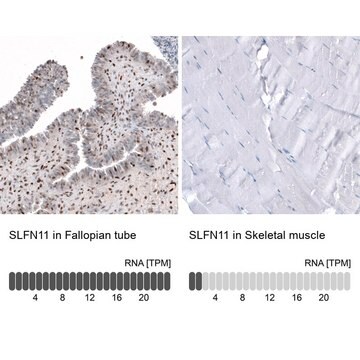General description
Replicase polyprotein 1ab (UniProt: P0C6X7; also known as pp1ab, ORF1ab polyprotein) is encoded by the rep (also known as 1a-1b) gene (Gene ID: 43740578) in SARS-CoV. It is a multifunctional protein involved in the transcription and replication of viral RNAs. It also contains the proteinases responsible for the cleavages of the polyprotein. Following its synthesis, replicase polyprotein is cleaved into 15 different chains that includes several non-structural proteins, 3C-like proteinase, proofreading exoribonuclease, helicase, uridylate-specific endoribonuclease, 2′-O-methyltransferase, and an RNA-directed RNA polymerase (RdRp) (EC:2.7.7.48), which is localized in amino acids 4370-5301. Most RNA viruses, with the exception of retroviruses, require an RdRp for replication and transcription of the viral genome, hence is important for their survival. The active site of the RdRp is the most conserved and accessible region and targeting this region for inhibition of viral replication is considered as an effective therapeutic approach. RdRp catalyzes RNA-template dependent formation of phosphodiester bonds between ribonucleotides in the presence of divalent metal ions. The initiation of synthesis occurs at the 3 -end of the template in a primer-dependent or independent manner and proceeds in the 5 → 3 direction. The catalytic site of Sars-CoV-2 RdRp is composed of a catalytic subunit known as nsp12 and two accessory subunits, nsp8 and nsp7. Its structure is highly similar to the RdRp of SARS-CoV. The core RdRp domain consists of the thumb, palm, and the fingers subdomains that are primarily involved in template binding, polymerization, nucleoside triphosphate (NTP) entry and associated functions. The palm subdomain houses most of the structurally conserved elements involved in catalysis. The thumb subdomain contains residues that are involved in packing against the template RNA and stabilize the initiating NTPs on the template. The finger subdomain holds the template RNA in place and facilitates polymerization. (Ref.: Aftab, SO., et al. (2020). J. Transl. Med. 18(1); Article 275; Hillen, HS., et al. (2020). Nature. 584 (7819); 154-156; Venkataraman, S., et al. (2018). Viruses. 10(2); 76).
Specificity
Clone 4E6 is a mouse monoclonal antibody that detects RNA dependent RNA polymerase R2 of SARS‐CoV.
Immunogen
Recombinant GST-tagged RNA dependent RNA polymerase R2 of SARS‐CoV.
Application
Quality Control Testing
Evaluated by Western Blotting with recombinant SARS-CoV-2 RdRp (NSP12) protein.
Western Blotting Analysis: A 1:250 dilution of this antibody detected recombinant RdRp R2 of SARS-CoV-2.
Anti-RdRp R2 of SARS-CoV, clone 4E6, Cat. No. MABF3026, is a mouse monoclonal antibody that detects RNA-dependent RNA polymerase of SARS-CoV and is tested for use in Western Blotting.
Physical form
Purified mouse monoclonal antibody IgG1 in buffer containing 0.1 M Tris-Glycine (pH 7.4), 150 mM NaCl with 0.05% sodium azide.
Storage and Stability
Recommend storage at +2°C to +8°C. For long term storage antibodies can be kept at -20°C. Avoid repeated freeze-thaws.
Other Notes
Concentration: Please refer to the Certificate of Analysis for the lot-specific concentration.
Disclaimer
Unless otherwise stated in our catalog or other company documentation accompanying the product(s), our products are intended for research use only and are not to be used for any other purpose, which includes but is not limited to, unauthorized commercial uses, in vitro diagnostic uses, ex vivo or in vivo therapeutic uses or any type of consumption or application to humans or animals.
